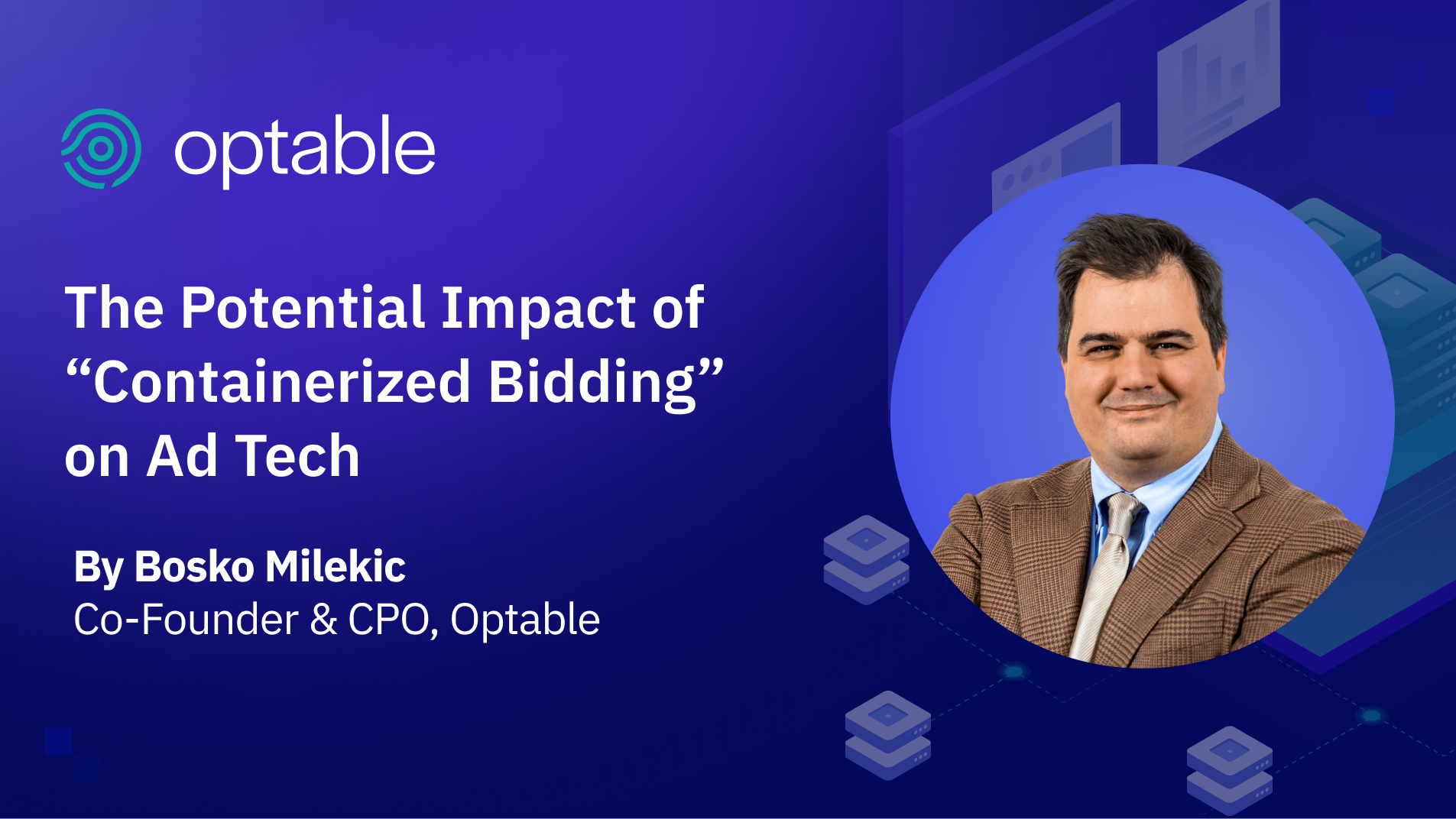Optable Blog
Learn about the modern advertising landscape and how Optable's solutions can help your business.
Thank you to everyone who joined us for Optable Connect 2025. This year’s theme was clear: AI is moving from buzzword to backbone. Across keynotes, live demos, and candid panel debates, we saw how the industry is stitching together data, automation, and standards to create real business value for publishers, marketers, and technology partners.
We’re sharing the highlights, the big ideas, and practical takeaways you can bring back to your teams.
The Big Idea: Agentic Collaboration + Open Standards
In the opening, Optable's CEO, Vlad Stesin framed an industry in transition: more first‑party data, more privacy pressure, and faster AI cycles — with power steadily shifting toward publishers. The question is how to turn that shift into durable value. Our answer: Agentic Collaboration (human‑in‑the‑loop AI agents working across adtech workflows) and AdCP, the Ad Context Protocol, a standard that lets those agents and platforms talk to each other reliably. Learn more about AdCP.
Vlad Stesin laid out definitions and the vision of agent‑driven planning, activation, measurement, and optimization with people in control of the loop. Most importantly, he envoked in the audience a strong call to action - lets built this ecosystem together.
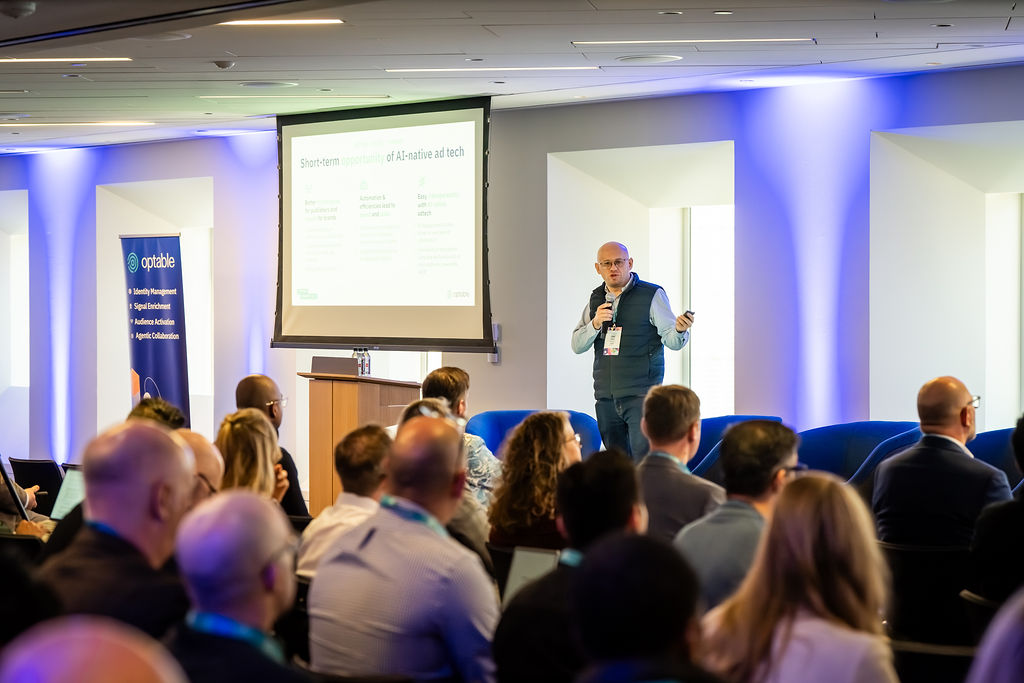
AI in Action: From Brief to Audience (and Back Again)
In the live product session Optable's CPO, Bosko Milekic, and Jeremie Lasalle Ratelle, CTO, showed Planner Agent working the way teams work: read a brief, propose audiences, find pre‑built segments, activate, and share relevant insights — and importantly, say “I don’t know” when it should.
We also previewed how AdCP underpins agent‑to‑agent and agent‑to‑platform communication, connecting buyer and seller agents through shared standards.
Takeaway: Bringing prompts to data — with standards for how agents exchange context and results — compresses planning cycles and keeps humans firmly in charge of strategy.

Session Highlights
1. AI in Media Buying: What’s real, what’s not, and where we’re going
Moderator: Vlad Stesin (Optable)
Speakers: Brian O’Kelley (Scope3), John Hoctor (Newton Research), Michael Driscoll (Rill Data)
This conversation separated real progress from hype. Themes included:
- Control vs. automation: Agent frameworks are useful only if they’re transparent and auditable; the buyer stays the editor‑in‑chief.
- Signals that matter: As identifiers fade, resilient signals (quality context, consented first‑party data, robust outcomes feedback) become the bedrock.
- Standards momentum: Agents need a common language; AdCP emerged as that connective tissue for planning and buying.

2. From Signal Loss to Signal Intelligence: Driving Performance with AI & First-Party Data
Moderator: Patrick Viau (Optable)
Speakers: Adam Heimlich (Chalice AI), Lindsay Van Kirk (People Inc), Chris Feo (Unity)
The group showed how to turn sparse, privacy‑safe inputs into actionable “signal intelligence.”
- AI fills the gaps by learning from patterns across contextual, behavioral, and first‑party signals — not by recreating invasive identifiers.
- Clean collaboration environments and data interoperability are now table stakes for responsible, high‑performance activation.
- Practical step: start by improving first‑party data quality (schema, freshness, event depth) before layering AI models.

3. How Content Owners Can Navigate Their Relationship With AI Giants
Presenter: Anthony Katsur (IAB Tech Lab) joined by Jonathan Roberts (People Inc.)
Anthony Katsur delivered a wake-up call for publishers facing signal and traffic loss in the age of AI. He explained how LLMs freely crawl and summarize the open web, disrupting the traditional value exchange that once drove site visits and revenue.
To address this, he introduced the Content Monetization Protocol (CoMP) — a new technical framework that enables publishers to set access terms, authenticate usage, and monetize AI queries. The initiative includes secure API-based communication, tokenized content tracking, and a phased rollout:
- Phase 1: Establish API controls and crawler access and discovery standards
- Phase 2: Build monetization models like cost-per-query
His main message: It’s time for publishers to get paid for the value their content brings to AI models.

4. Creating a Buyer & Seller Win‑Win With Curation
Moderator: Rob Beeler (Beeler.tech)
Speakers: Paul Bannister (Raptive), Lori Goode (Index Exchange), Kyle Vidasolo (Elcano)
Curation is evolving from “nice to have” to efficiency engine:
- Publishers gain yield, control, and transparency.
- Buyers get cleaner supply paths, clearer audience definition, and measurable outcomes.
- The most compelling examples came from publisher‑SSP‑curation partnerships, showing how audience + inventory packaging can outperform the open marketplace when executed with shared incentives.
.jpg)
5. Fueling Smarter Media: Data & AI with Hearst and The Weather Company
Moderator: Kristy Schafer (Optable)
Speakers: Jessica Hogue (Hearst), Felix Zeng (The Weather Company)
Two leaders shared what it looks like to be AI‑ready end‑to‑end:
- Data architecture first: Organize front‑end use cases (personalization and advertising) atop back‑end structures that make data ML‑ready.
- Context is a superpower: Weather‑driven and behavioral signals unlock relevant experiences and new monetization paths — from syndicating data to vertical partners to novel ad formats.
- Cross‑device and journey insights: Several examples showed how consolidating consented signals informs both UX and yield.

6. How the Data Landscape Is Helping Power the Next Era of Addressability
Moderator: Andrew Dumas (Optable)
Speakers: Jonathan Durkee (True Data), Mathieu Roche (ID5), Ryan Teshima-McCormick (MediaWallah)
The final panel discussed how the industry is adapting to a rapidly changing identity landscape, where cookies and device IDs are disappearing, and regulation is reshaping how data is used:
- The panel examined how adaptive, cross-channel identity frameworks are redefining addressability amid disappearing cookies and tighter regulations.
- Speakers agreed that fragmentation, not signal loss, is the core challenge, highlighting the need for standardized, interoperable approaches across CTV, mobile, and audio.
- First-party data and AI-driven probabilistic identity were cited as key enablers of more accurate, privacy-conscious targeting and measurement.
- The session concluded with a call for open, collaborative identity frameworks to create durable, future-ready addressability across the ecosystem.

Six Takeaways
- Make your data AI‑ready. Tighten schemas, enrich event depth, and ensure governance so agents can act confidently on your data.
- Adopt agentic workflows where they help most. Start with planning and audience construction; keep humans in the loop to set strategy and guardrails.
- Lean into curation. Package high‑quality audiences with transparent supply paths; align incentives so “win‑win” isn’t just a slogan.
- Build on open standards. Agents need a shared language — AdCP for collaboration across planning, activation, and optimization.
- Measure what matters. As signal fragmentation grows, optimize to outcomes and value, not vanity metrics. Our own results show that improved addressability can correlate with 35%+ CPM uplift when audiences get demonstrably more valuable.
- Prepare for the next era of addressability. Focus on interoperable identity frameworks, first-party data, and AI-driven probabilistic models to create durable, cross-channel addressability grounded in trust and transparency.
What’s Next
Our focus remains the same: help publishers and their partners monetize more effectively by connecting data, AI, and standards into a working system.
- We’ll continue to invest in enterprise‑scale identity and signal activation — the groundwork for intelligent workflows.
- We’ll deepen Agentic Collaboration — practical agents, transparent controls, and interoperability via AdCP.
If you joined us, thank you for the energy and open conversation. If you couldn’t make it, we hope this recap helps you catch up — and we’d love to keep the discussion going.
Let’s build the connective tissue of this new ecosystem — together.
Programmatic advertising, which automates the buying and selling of digital ads, has long relied on third-party cookies, which have enabled publishers to deliver personalized content to individuals based on behavior across websites.
However, with the combination of increasing global privacy regulations and major web browsers phasing out third-party cookies, the landscape of digital advertising is rapidly evolving. Understanding these shifts is essential for publishers and advertisers striving to balance privacy with effective ad targeting and campaign performance.
The decline of numerous signals including third-party cookies has left a significant gap in the digital advertising world, but Universal IDs are emerging as a powerful solution. Instead of relying on unreliable data like cookies, these new identifiers use trusted first-party information to recognize individuals across digital platforms.
This unified approach provides companies with more accurate identity resolution and better targeting capabilities. It also gives publishers a deeper understanding of their audience, which helps them enhance their advertising efforts. Ultimately, Universal IDs are a standardized, privacy-friendly solution that allows the entire ad tech ecosystem to navigate a modern, privacy-conscious landscape.
"Universal IDs are a valuable asset to consider. These solutions can unlock the ability to increase ROI, reach more users, and deliver campaign objectives across both cookie-based and cookieless environments. Ultimately, they replace the capabilities that cookies have been used for in a privacy-compliant way." – ID5
Types of Universal IDs: Understanding Your Audience to Enhance Targeting
Universal IDs may be built on various technologies and methodologies to enable consistent visitor identification across platforms, with each type offering a specific approach to recognition and privacy compliance. Some solutions also focus on interoperability, allowing IDs to work across different systems and environments.
Deterministic Universal IDs
Deterministic Universal IDs are generated from directly identifiable and verified data, such as email addresses, phone numbers, or login credentials – typically first-party data collected via logins or subscriptions. These identifiers are secured using cryptographic hashing or encryption, transforming the original data into anonymized, fixed-length strings to protect privacy. Because they rely on authenticated data, deterministic Universal IDs deliver high accuracy with consistent recognition of individuals across devices and platforms, provided proper consent is obtained. This approach provides a way for advertisers to target individuals across platforms with high precision while respecting privacy choices.
Probabilistic Universal IDs
Probabilistic IDs use statistical models and machine learning to infer identity based on patterns in behavior, device attributes, IP addresses, and other signals. Typically used to complement deterministic identifiers in hybrid approaches, probabilistic IDs are not tied to a single, verified identity – but are built on the likelihood that different signals belong to the same person. This approach is also useful when deterministic data is unavailable, such as environments where consented, first-party data is sparse. Publishers that don't have access to login data may rely on probabilistic IDs to improve targeting and attribution.
Publisher-Generated First-Party IDs
Publisher-generated first-party IDs are generated by publishers based on their first-party data. Often collected via logins, subscriptions, or on-site behavior, this data is then used to build audience profiles, setting the foundation for publishers to onboard their first-party data and connect it with advertisers' audiences. This approach maintains Identities within a publisher's network, offers secure, anonymized data that can be shared with approved partners, and can be mapped to other Universal ID systems via identity resolution.
Universal IDs vs. First-Party Data
While closely related, Universal IDs and first-party data are not the same thing, but they do work together in the evolving digital advertising ecosystem. First-party data refers to the information a company collects directly from its visitors through interactions such as subscriptions, purchases, surveys, feedback forms, and account registrations. This data is considered highly valuable because it's accurate, consent-based, and directly tied to real individual behavior and preferences.
First-party and offline data are often the foundational sources used to fully leverage Universal IDs. When a publisher collects an email address or login ID from an individual, this information can be hashed and used as the basis for matching with a Universal ID that enables consistent subscriber recognition.
A Universal ID is a unique, persistent identifier assigned to an individual, enabling recognition across various platforms, devices, and ad tech systems, without relying on third-party cookie syncing. These IDs are usually created by ad tech vendors, identity solution providers, or industry coalitions.
What sets Universal IDs apart is their interoperability, allowing various participants in the advertising ecosystem – publishers, supply-side platforms (SSPs), demand-side platforms (DSPs), and advertisers – to recognize and target the same individual across channels with consistency and precision.
The Importance of Universal IDs: Navigating The Decline of Cookie Advertising
Driven by the industry-wide shift away from third-party cookies, Universal ID solutions have emerged as a sustainable and privacy-forward solution for identity resolution. The ecosystem, enabled by Universal IDs, empowers both publishers and advertisers to deliver secure experiences across the digital advertising supply chain. By leveraging first-party data collected directly from subscribers, Universal IDs create a consistent, shared identity, enabling effective targeting, improving user experience, and allowing advertisers to serve relevant ads across platforms.
Traditionally, disparate IDs had to be synchronized to recognize a person across platforms. Because there's no single standardized identifier shared across platforms in the traditional cookie-based ecosystem, the cookie-syncing method creates latency and diminishes performance. This complicated syncing process not only increased the risk of data loss but also slowed page load times and reduced match rates due to fragmentation and a lack of standardization.
By combining anonymized data with cross-domain tracking capabilities, Universal IDs eliminate the need for complex and inefficient cookie-syncing processes, acting as a unified identifier that all approved parties can use. This reduces development overhead and improves efficiency in data matching, ad delivery, and performance measurement.
Benefits of Universal IDs
- Eliminate reliance on third-party cookies and cumbersome data-syncing services
- Enhance data accuracy and identity resolution, delivering better match rates
- Reduce duplication and enable precise sample sizes for ad targeting
- Securely store authenticated first-party data on dedicated platforms
- Align ad targeting more closely with individual interests for improved campaign performance and more relevant ad delivery
- Increase revenue opportunities through higher-value impressions
- Ensure accurate cross-platform recognition without relying on device-specific cookies
- Empower marketers to offer visitors meaningful value (loyalty programs, personalized experiences, gated content, etc.) in exchange for their information
The Future of Universal IDs: Navigating the Cookie-Less Future
Major browsers are already blocking third-party cookies and IPs, and publishers and advertisers are under increasing pressure to find sustainable alternatives for identity resolution. With the void left by third-party cookies, Universal IDs offer a more robust, future-proof, and standardized approach to identity resolution. They have been steadily gaining traction and emerging as one of the most promising tools in this evolving landscape.
While the groundwork for Universal ID adoption is well underway, the ecosystem is still maturing. Key challenges remain around interoperability, industry-wide standardization, and ensuring compliance and transparency.
Universal IDs represent a strong foundation for the future of personalized advertising in a privacy-first world. As the complete phaseout of third-party cookies approaches, the effectiveness and adoption rate of Universal IDs will become even clearer. However, the true impact will only be known once cookies are fully deprecated across all major platforms.
Enhancing Addressability with Optable
With a unified, privacy-compliant framework that can work across the open web and programmatic ad channels, Universal IDs enable precision targeting, consistent user experiences, and higher match rates for advertisers.
With cookies on their way out, Optable enables media owners to create premium, privacy-safe media activations. Get in touch with us to learn how we power seamless compatibility with the advertising ID ecosystem.
Read more about how Optable turns data into opportunity with Universal ID solutions.
When publishers think about their identity spine, the focus is often on coverage, accuracy, and match rates. But there is another dimension that’s just as critical, and often overlooked: flexibility.
Your audience data, your AdTech stack, and your business goals are always evolving. What you decide today as your “primary” identifiers might not be the right choice six months from now. The question is, when those needs change, do you have the freedom to adapt on your terms, or are you locked into a costly, time-consuming rebuild?
The problem with rigid graphs
In most identity graph implementations, the structure is fixed the moment data is ingested. Your linkage rules, such as which IDs are considered primary and which are fallback, are baked into the schema. If you want to make a change, you often need to:
- Re-ingest and re-process your entire visitor dataset
- Rebuild linkages from scratch
- Pause other projects while the engineering team manages the migration
For publishers managing large volumes of historical and real-time 1st party data, this rigidity creates operational drag. Every re-ingest is costly in terms of infrastructure resources, internal effort, and time to market.
Flexibility by design with Optable
With Optable, flexibility is built into the core of how identity resolution works. You can change primary identifiers at any time, adjust linkage rules to accommodate new data sources or advertising use cases, and apply different scopes of resolution. Scopes give you the freedom to tailor how identity is managed for different objectives, ensuring that activation and enrichment each work the way you need, without reloading or migrating data.
The Optable platform is built around schema on read. Instead of locking your data into a rigid structure when it is ingested, the platform continuously evaluates and resolves your ID graph data into a normalized list of visitor records based on your latest configuration every time it is accessed.

Why schema on read matters
For the non-technical stakeholders among us, schema on read means the platform interprets the data’s structure at query time rather than load time. This is especially advantageous in a fragmented publisher environment because it:
- Works with mixed data sources, including batch, real-time, and warehoused
- Adapts instantly when new identifiers or linkages are introduced
- Avoids downtime and heavy ETL cycles when changes are needed
For programmatic and yield leaders, this translates into agility. You can test new audience strategies, onboard different partners, or pivot targeting rules without waiting on long engineering sprints.
Adapting as you learn
Your identity strategy will evolve as you learn. You might start with hashed emails as your primary key, then later shift to a deterministic on-site identifier, or you might add probabilistic linkages for specific activation use cases.
With a flexible identity graph hosted by Optable, those changes are configuration updates, not re-architecture projects. Scopes make this adaptability even more powerful: you can fine-tune identity resolution for one use case without disrupting another. That means you can test, learn, and optimize with confidence, improving performance while keeping operations streamlined.
The takeaway
A flexible identity graph is not just a technical convenience; it’s a business advantage. It allows you to:
- Respond faster to changes in data availability and privacy regulations
- Unlock new monetization and activation use cases faster
- Align identity resolution with your business goals using configurable scopes
- Reduce the operational overhead of managing your audience data
If you are building or rethinking your identity solution, ask yourself: will this graph adapt with me, or will it hold me back? With Optable, you can ensure it is built to adapt.
For many publishers, there are really two stories of AI.
The first is the dark one: the story of web publishers whose content is scraped, remixed, and redistributed without compensation. It threatens the very foundation of the open and free web. A web that, in large part, is funded by advertising.
The second story is brighter, and it’s the one I want to focus on here. It’s the story of publishers and advertisers leveraging modern AI. More specifically, large language models (LLMs), autonomous agents, and expert assistants that can help to better align marketing goals with audiences.
Both stories matter. But let’s stay with the second one for a change.
Why AI?
When we first started experimenting with LLMs, my mental model was simple: imagine platform workflows augmented by a digital advertising version of Clippy. Smart assistants that could translate natural language into SQL queries, run an audience model, or generate a campaign report. Some of these assistants would be useful, others less so, especially since, as I’ve learned, humans will do almost anything to avoid having to talk to a bot. But the picture was still one of “tools that help humans get stuff done.”
Now that we’ve been at this for some time, the more exciting question has emerged: what happens when these assistants aren’t just helpers, but collaborators?
Allow me a quick digression. Having been around digital advertising for a while (and perhaps this is the old man in me talking), I remember when advertisers and publishers actually talked about ad campaigns. Communication often happened over email, sometimes on the phone. Video calls weren’t the norm yet. The cast of characters included publisher sales reps and media agency buyers, with ad ops, analysts, and data teams on both sides.
Sounds inefficient, right? And it was. But there was a benefit to that complexity: when decent people talk directly, trust and accountability come built in. You tend to share more about your actual goals. You try harder to make things work. Reputation and repeat business were always on the line.
Fast forward to today: real-time auctions have brought incredible efficiencies, but they’ve also eroded some of that organic incentive alignment. The frictionless protocol stripped away some of the humanity and creativity that is core to advertising.
So here’s the emerging question: putting aside cost of sale and scale challenges for a moment, what if advertisers and agencies could once again design and run campaigns by interacting more directly. Not just with humans, but with agents acting on behalf of humans, using the same kind of natural language to exchange thoughts and ideas and help align goals and objectives? Could this better align advertiser goals with audiences? Could it make advertising feel better, behave better, work better?
That’s worth getting excited about.
What We’ve Learned So Far
Working with LLMs has taught us something both obvious and profound: they are dazzling at simulation, but shallow at self-awareness. They can produce fluent, convincing responses and even mimic reasoning, but they have no reflexive capacity to recognize when they’ve gone astray. The outputs can be brilliant in one moment and dangerously wrong in the next, with equal confidence.
This duality means that while LLMs can simulate many human workflows, from drafting creative copy to parsing data schemas, they must be deployed carefully. They thrive when given the right scaffolding: a contained problem space, clear context, and a well-bounded objective. Left unconstrained, they risk drifting, fabricating, or amplifying error.
That’s why the path forward hasn’t been about building one all-knowing digital assistant, but rather assembling constellations of specialized agents. Each is trained or prompted for a narrow domain of competence: a media planning agent, a data transformation agent, an audience segmentation agent. These agents are better behaved precisely because their world is smaller and the teams building them can impart context and create clear guardrails based on deep domain knowledge. Instead of asking them to “understand everything,” we’re asking them to execute well-defined tasks within a shared environment.
Of course, even narrow specialists are only as useful as their ability to work together. And this leads to the bigger frontier.
Agentic Collaboration in Digital Advertising
If specialized agents are the components, collaboration is the system. Real work rarely lives inside the walls of a single agent. Planning a campaign, for instance, may begin with a creative brief that must be interpreted by one agent, handed to another to model against audience data, and then routed to yet another to generate media plans and validate them against inventory. Without coordination, this quickly becomes chaos.
This is why the idea of Agentic Collaboration is so compelling. It is not enough to build competent agents; we need ways for them to communicate, to delegate, to negotiate, and to reconcile. Inside an organization, this means establishing frameworks where multiple agents can operate on the same context, share state, and pass tasks fluidly without losing fidelity. Across organizations, the challenge becomes even more interesting: what happens when an advertiser’s agents need to converse directly with a publisher’s agents, or when third-party specialist agents need to be introduced into the workflow?
At that point, protocols matter. Just as real-time bidding was only possible once the industry coalesced around shared protocols and standards for describing inventory, price, and demand, agentic collaboration will require structures for intent, context, and trust. Compelling new protocols such as MCP and A2A have emerged to support a new infrastructure across our industry. If agents are to transact meaningfully on behalf of their human principals, we will need conventions for verifying what they can and cannot do, and for ensuring that their exchanges reflect not just efficiency, but accountability.
The product implication is enormous. Platforms like Optable’s are no longer just facilitating data exchange or workflow automation; they are becoming the medium in which agents collaborate. That means exposing enough functionality and data to make collaboration useful, while constraining enough to keep it safe and aligned. It means thinking carefully about how agents identify themselves, how they signal authority, and how they fail gracefully when they don’t know the answer.
If this sounds familiar, it should. In some sense, we are circling back to the kind of direct communication that once characterized the industry only now, the conversations are mediated by software agents that can operate at machine scale and speed. Done well, this can fundamentally upgrade the methods to establish trust, alignment, and shared understanding in digital advertising.
What We’re Up To
At Optable, our starting point was building a platform where publishers and advertisers could collaborate transparently on data, without intermediaries diluting the signal or hoarding the value. That same conviction now extends naturally into the world of AI.
Agentic collaboration, to us, is not about replacing humans. It’s about restoring what was lost when programmatic scaled: the trust and alignment that come from two parties working directly toward a shared objective. The difference is that now, agents can help scale those conversations across thousands of campaigns, billions of impressions, and an ecosystem that demands both speed and precision.
Our role is to provide the medium where this can happen safely, particularly from the perspective of publishers, the creators that make the free internet possible, and the custodians of user and audience data. That means building the infrastructure where specialized agents, some ours, some yours, some built by our partners, can meet, exchange, and work together under clear rules. It means designing protocols that enforce accountability and safeguard data, while allowing creativity and experimentation to flourish. And it means ensuring that when agents collaborate across organizational boundaries, they are still serving the fundamental goals of the humans they represent.
This isn’t just a product roadmap. It’s a philosophy. Advertising at its best has always been about connection: between brand and audience, between publisher and advertiser. By enabling agentic collaboration, we have the opportunity to bring that connection into the AI era not by automating away the conversation, but by amplifying it.
We’re still at the beginning of this journey, but beginnings matter. And if history has taught us anything, it’s that the structures we design now, meaning the protocols, the incentives, the norms, will shape the industry for decades to come. Our intention is to help shape them in a way that makes advertising more accountable, more collaborative, and, ultimately, more human.
As third-party cookies, mobile ad IDs, and IP-based tracking fade into obsolescence, media companies are being forced to rethink how they reach, understand, and monetize audiences. For publishers, ad networks, and media owners, the loss of shared identifiers is no longer just a compliance issue—it’s a direct challenge to revenue.
But here’s the opportunity: addressability isn't gone—it’s evolving. And those who build flexible, privacy-first identity strategies will be the ones who win the next phase of audience monetization.
Want the full roadmap to building your identity strategy? Download our Sell Side Guide to Identity for a deep dive into building first-party infrastructure, evaluating identity partners, and activating audiences across programmatic and direct channels.
Addressability Isn’t One ID—It’s a System
Historically, publishers leaned on a shared set of identifiers—cookies, MAIDs, and shared IPs—to reach users across the web. That model is breaking down. Today, addressability is about creating direct, trusted connections with your audience—and making those connections measurable and monetizable.
To stay competitive, publishers must:
- Rely more on first-party data collected through authenticated logins, subscriptions, and engagement signals
- Use multiple identity frameworks (UID2,Yahoo Connect ID, Criteo ID, PubLink, ID5, NetID, etc.) depending on the buyer or channel
- Enforce privacy rules and consent management at the foundation of every audience interaction
Identity = 1P Data and Enrichment, Not Just IDs
A strong identity framework isn’t just about having an ID for every user—it’s about composing a blend of high-quality signals that allow for targeting, measurement, and collaboration. These include:
- First-party signals: logins, hashed emails, page visits, subscriptions, preferences
- Third-party enrichment: demographics, interests, behaviors from verified external sources
- Contextual and engagement data: what users are reading, watching, or clicking
The more intentionally these signals are combined, the more addressable—and valuable—your inventory becomes.
Managing Multiple IDs Across Channels
Not every ID works everywhere. UID2 might perform better in programmatic web auctions, while Publisher PAIR ID or PubLink are better suited for authenticated environments or clean rooms. That’s why leading publishers are moving toward supporting multiple identity providers—a flexible setup that:
- Routes different IDs and signals based on buyer, channel, and compliance
- Suppresses or enhances signals based on consent and privacy rules
- Enables interoperability across SSPs, clean rooms, and measurement platforms
Think of it as adopting tools that make it possible to activate the right identity in the right channel, while remaining privacy-compliant.
Proving ROI: Identity-Driven Monetization in Action
The most successful teams treat identity not as a backend system—but as a frontline revenue strategy. When implemented effectively, identity unlocks tangible value:
- Higher CPMs and fill rates through enriched bid requests
- Stronger direct deals thanks to better audience insights and curated packages
- Improved campaign performance when activating audiences in clean rooms
- Better measurement and feedback loops that inform data-driven optimization
Start With What You Have—and Build Strategically
You already have the foundation: your audience, your content, and your data. Now it’s time to compose your identity graph in a way that delivers measurable business outcomes. Start with deterministic identifiers. Layer on enrichment where it matters. Integrate flexible technology that’s privacy-compliant and future-ready. Read our step-by-step guide on how to build a first-party identity graph.
The era of easy targeting is over. But the era of intentional, high-impact addressability is just beginning.
Learn More about Addressable Advertising
For tactical steps, team checklists, and monetization best practices, download the Sell Side Guide to Identity and start building your addressable advantage today.
Inside Identity: Rob Beeler, in an interview with Optable’s Alexandre Guertin-Aird, VP of Customer Solutions
The interview below was created in the partership with Beeler.Tech team and Rob Beeler. You can find the original publication on the Beeler.Tech's blog here.
------
Third-party cookies are on life support. Programmatic is evolving fast. And the only thing publishers can truly control? Their data. That’s where identity strategy becomes the make-or-break factor.
Recently, Rob Beeler sat down with Alexandre Guertin-Aird, VP of Customer Solutions at Optable, to talk about how leading publishers are rethinking identity, signal enrichment, and monetization.
Whether you're building your first-party graph from scratch, or trying to squeeze more out of your existing setup, Alexandre offers a clear view into what works, what doesn’t, and where the real ROI is hiding.
Rob: I agree that the first step in building an identity strategy is to determine goals and requirements, but I know people struggle at this phase, in part because it spans multiple departments. What have you seen some of your best clients do that helped them nail this phase?
Alexandre: The most consistent pattern we see is strong internal ownership. The clients who succeed in this phase usually have a clear internal champion - someone who understands the strategic importance of identity and takes accountability across teams. That person might sit in product, audience development, adops, or even revenue - what matters is that they have the mandate and persistence to drive alignment.
In more complex organizations, this leader often needs executive sponsorship - from a CRO, CDO, or head of digital - to break down silos. We’ve seen this work incredibly well across organizations like Unity, Hearst, and SJC. These teams didn’t treat identity like a “tech project.” They started with the business case - how it impacts revenue, profitability, and growth. Then, they built cross-functional working groups that included stakeholders from audience, adops, legal, data engineering, and product strategy. That early alignment is what sets the foundation for long-term success.
Rob: Success can take many different forms, and you outline several success metrics to help align expectations. For many people advocating for investment in this area, quick wins are key. What’s some low-hanging fruit most publishers can go after?
Alexandre: The quickest path to ROI is typically through injecting more signal into the programmatic bid stream using the publisher’s own identity graph. We’ve seen clear lifts in CPMs and fill rates when more signal is present - it’s one of the most immediate levers publishers can pull when it comes to addressability.
The challenge is that publishers either feel they don't have enough first-party data to make a difference, or they don't have the technical resources to manage the integrations (or a combination of both). To solve this, we developed our ID Switchboard solution, which simplifies integration with both enrichment sources and alternative ID frameworks. It removes the friction and technical overhead that many publishers face. With this approach, we've seen publishers report 4-7% lifts in open programmatic revenue, and ROI often multiplies 5x within just a few months.
There are other tools that offer similar capabilities, but many come with costly rev-share models. We believe publishers should own their own graph. That control unlocks not only immediate monetization, but also sets the stage for audience enrichment and data collaboration strategies down the road.
Rob: Of the steps outlined, where do you feel most publishers need to spend more time than they anticipate?
Alexandre: Great question, and there’s no one-size-fits-all answer. The big one is developing a cohesive ad monetization strategy that unifies both direct and programmatic sales. The old playbook of direct for premium, and programmatic for remnant inventory, doesn’t apply anymore. DealIDs, cookie deprecation, and agency curation have blurred those lines.
Today, publishers must manage multiple demand channels - including fellow media owners! - and think critically about rate card strategy, yield management, and channel conflict. Publishers who work hard to align their internal monetization teams, and treat identity as core infrastructure rather than an afterthought, will see great results in both the long and short term.
Another important factor is ensuring that the programmatic setup is technically sound. Too many calls on the page can lead to errors, latency, or other unexpected behaviors that can ultimately prevent the signal enrichment of bid requests.
Rob: There are so many identifiers in the marketplace and it feels like buyers are using all of them. Should publishers focus on just a few major ones, or try to integrate as many as possible?
Alexandre: This is a great follow-up to the previous question because it highlights the need for publishers to think strategically and long-term when selecting identity partners. Not all IDs are created equal - some are better integrated with programmatic, whereas others shine in direct-sold environments. For example, if premium ad deals are a priority, it makes sense to focus on identifiers that are well-integrated with direct channels, not just programmatic. From there, other factors come into play - such as security, transparency, buy-side adoption, coverage across key markets, and whether the ID can be implemented into header bidding setups.
At Optable, our customer success and solutions teams work closely with publishers to navigate this complexity, often by running tests across multiple identifiers. We always recommend working with a select mix of partners to maximize coverage and flexibility. Testing is essential, but the strategy should be deliberate, not just additive.
Rob: How can I collaborate with identity enrichment partners and integrate my own first-party data into the mix, ensuring my inventory stands out? Is that possible… and practical?
Alexandre: Not only is it possible - it’s one of the most common use cases we support. It starts with building a first-party identity graph, which means centralizing your data and resolving it into identity clusters. With Optable, publishers can use SDKs, APIs, and direct integrations to onboard and resolve data in a privacy-safe way.
We’ve built a flexible architecture that supports signal enrichment both in real time and in batches. We also normalize and prune third-party datasets automatically, so publishers aren’t wasting internal resources on manual data cleanup.
To preserve integrity, we recommend publishers maintain separate graphs for third-party enrichment data - this protects the core identity graph while still leveraging signal enrichment to enhance addressability.
Once the graph is live, Optable’s ID Switchboard becomes a unified, dynamic dataset that can support many use cases, and allows publishers to inject identity signals into bid requests using a wide array of alternative ID frameworks - like UID 2.0, Yahoo Connect ID, or Criteo Encrypted HEM. This makes inventory more addressable, improves advertiser targeting, and ultimately drives higher yield - all while staying privacy-compliant.
What’s Next for You?
Whether you’re a publisher with deep first-party data, or just beginning your identity journey, one theme is clear: strategy trumps tools. Identity isn’t a tech project - it’s a business initiative that requires internal champions, cross-functional collaboration, and deliberate planning. As Alexandre emphasizes, publishers who build for flexibility and ownership today are the ones best positioned to grow, adapt, and win tomorrow.
What is Identity Resolution? Unlocking Audience Data for Publishers
In the evolving digital ecosystem, users are interacting across an increasing number of devices and sites. Privacy regulations, such as GDPR and CCPA, are shifting privacy practices. New browser technologies are designed to limit cross-site tracking, and the use of third-party cookies is declining.
As these factors reshape the data landscape, publishers and media owners face a fundamental shift in how they collect and use audience information. This calls for new approaches to connect fragmented data while addressing privacy concerns. By turning these challenges into strategic opportunities, publishers can gain a competitive edge.
Today, robust first-party identity solutions are essential for publishers. ID resolution is a foundational process that integrates dispersed user data from websites, applications, and streaming platforms. This technique matches disparate data points from various sources to form a cohesive, privacy-compliant view of individuals. The process typically involves linking anonymous identifiers like device IDs and IP addresses with known signals such as login credentials and email addresses.
With reliable identity resolution, publishers can enhance targeting and personalization. This enables them to gain valuable audience insights, drive monetization, and protect user trust. By establishing these connections, publishers can more accurately recognize and track visitors across sessions, browsers, and devices, even when traditional identifiers are unavailable.
“Identity resolution is the process of integrating identifiers across available touchpoints and devices with behavior, transaction, and contextual information into a cohesive and addressable consumer profile for marketing analysis, orchestration, and delivery.” – Forrester
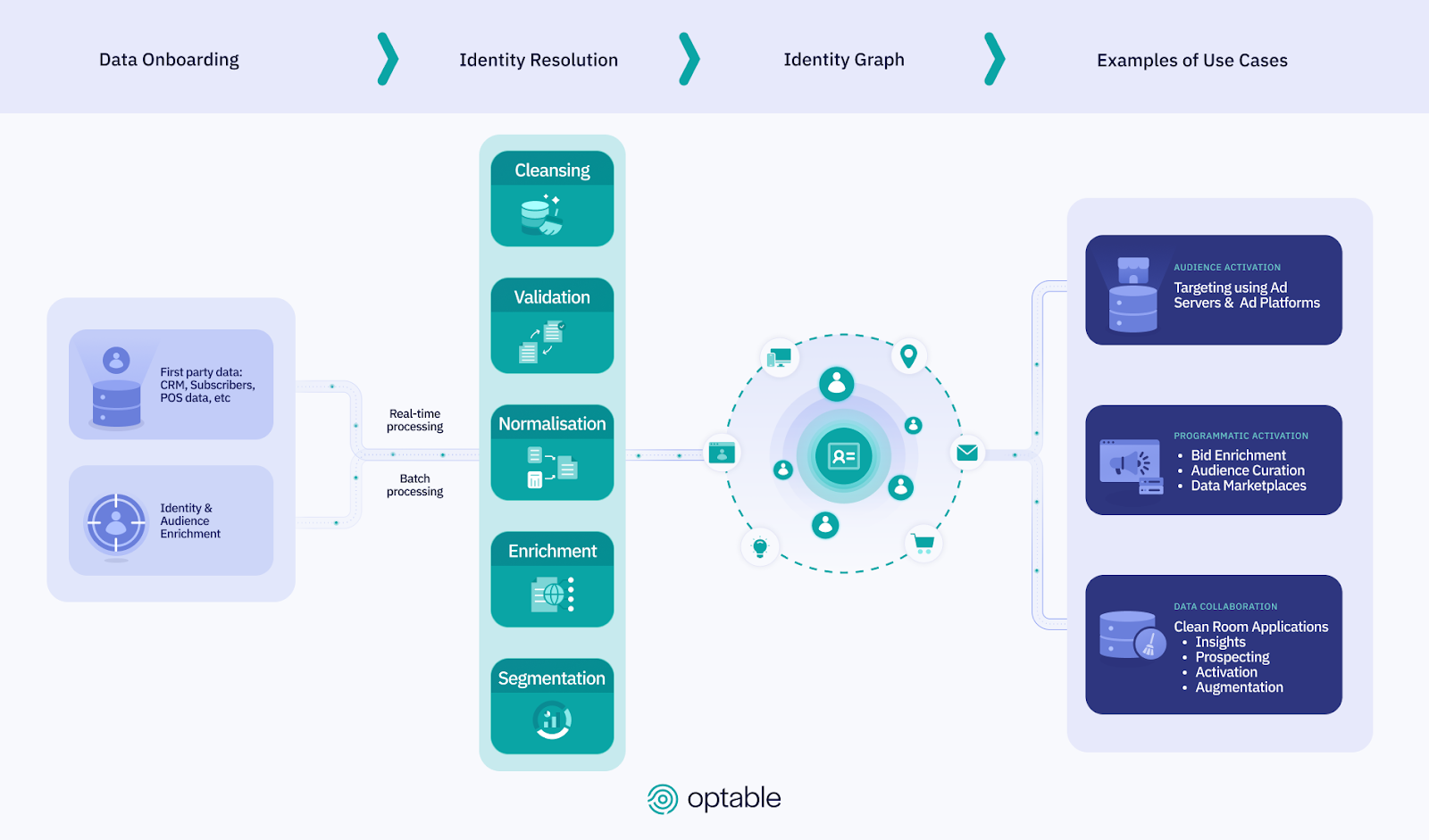
ID resolution often uses advanced algorithms and machine learning (ML) to connect scattered data points with the right individual. This helps to build a more complete understanding of their digital behavior. This can take place in real time, such as when someone visits a website or app, enabling immediate personalization of their experience and delivering targeted messaging.
For publishers, a more unified view of their visitors unlocks the ability to maintain a holistic understanding of their audience to:
- Better forecast & analyze their advertising inventory
- Tie interactions together to deliver more relevant content
- Foster stronger, more personalized audience relationships grounded in trust
- Reduce data fragmentation and minimize signal loss
- Optimize ad targeting and subscription strategies
The Importance of ID Resolution: Maximizing Data and Insights to Enhance Experiences and Grow Revenue
For publishers, resolving identity is key for increasing audience engagement and revenue to stay competitive in a privacy-focused landscape. A unified view of individuals is foundational for successful digital publishing strategies and sustained growth.
Publishers rely heavily on advertising revenue to sustain their operations and fund quality content. Accurate identity resolution enables more effective audience segmentation, forecasting, and targeting, leading to more customized advertising plans and better performance for advertisers. By capturing demographics, interests, behavioral patterns, and preferences, publishers can command higher rates and drive better campaign performance.
People frequently jump between mobile apps, desktop browsers, emails, and over-the-top (OTT) streaming platforms throughout their daily routines. Without identity resolution, publishers see only fragmented snapshots of visitor behavior, making it nearly impossible to understand the end-to-end journey or accurately attribute conversions and engagement.
ID resolution consolidates these fragmented sessions into individual visitor profiles. These cross-platform insights enable data-driven decision-making that improves content strategy, informs resource prioritization, and enhances overall audience activation efforts.
With accurate identity resolution, publishers and advertisers unlock opportunities for deeper engagement and can move beyond one-size-fits-all strategies to deliver personalized recommendations and relevant offers based on an audience's interests, behaviors, and purchase history.
How Identity Resolution Works: Crafting Real-Time Visitor Journeys for Dynamic Personalization
ID resolution is based on the core processes of data collection, matching, and real-time recognition to deliver personalized experiences and smarter ad targeting.
Data Collection and Ingestion
The process of identity management begins with collecting user data from multiple touchpoints, including owned platforms like websites, apps, and CRMs, as well as data warehouses where visitor data may also live. This data falls into two main categories: deterministic identifiers and probabilistic signals.
Deterministic identifiers, such as email addresses, phone numbers, and audience IDs, are explicit, verifiable pieces of information directly linked to individuals. These identifiers offer high accuracy for matching and identity resolution, but they can be challenging to scale due to their limited availability. To overcome this, organizations often rely on first-party data networks that aggregate these identifiers.
Probabilistic signals, like device types, IP addresses, browser versions, and behavioral patterns, provide likely – though not certain – matches to user identities. This approach analyzes patterns and similarities across channels and devices, enabling broader coverage and faster scaling of identity graphs, but with less precision than deterministic methods.
After collection, all data is ingested into centralized systems such as data warehouses or customer data platforms (CDPs), where identity resolution takes place. By combining deterministic and probabilistic data, organizations can construct unified visitor profiles from both authenticated and anonymous traffic.
Data Matching and Identity Graphing
Once data is collected and ingested, it is matched and organized into an identity graph – a dynamic database that stores relationships between identifiers and known profiles. The identity graph connects multiple data points to a single identity using a combination of exact and probabilistic matching.
Advanced identity resolution systems use ML algorithms to analyze these patterns and refine matches over time. These systems can distinguish between visitors with similar behaviors and recognize the same individual across sessions, even without explicit login events.
Identity graphs evolve as new data is collected and as users interact with different platforms and devices. Continuous updates and optimization processes ensure that the identity graph remains accurate and compliant.
Publishers oftentimes do not limit themselves to one graph. They maintain a distinct identity graph for their first-party data with authenticated traffic, while creating another one for second-party and first-party data for licenses or partnerships.
Profile Unification
After successful identity resolution, all relevant data is merged into a single, unified profile. This profile consolidates demographic information, behavioral insights, and engagement history across channels.
Profile unification enables the creation of a “golden record” – a single, consistent version of visitor data that all internal systems can access and update in real time. This unified profile eliminates data silos and provides a 360-degree view of each user.
Activation and Real-Time Recognition
Real-time identity activation transforms static data into actionable insights. Modern ID resolution platforms allow publishers to instantly recognize and identify visitors as soon as they interact with a website or app. This real-time recognition unlocks the potential for immediate personalization and tailored experiences that reflect each visitor’s journey.
These real-time platforms seamlessly integrate with marketing automation tools, personalization engines, customer data platforms (CDPs), and advertising systems. By activating identity data across these connected systems, organizations can orchestrate consistent messaging and cohesive experiences throughout the entire customer journey at every touchpoint.
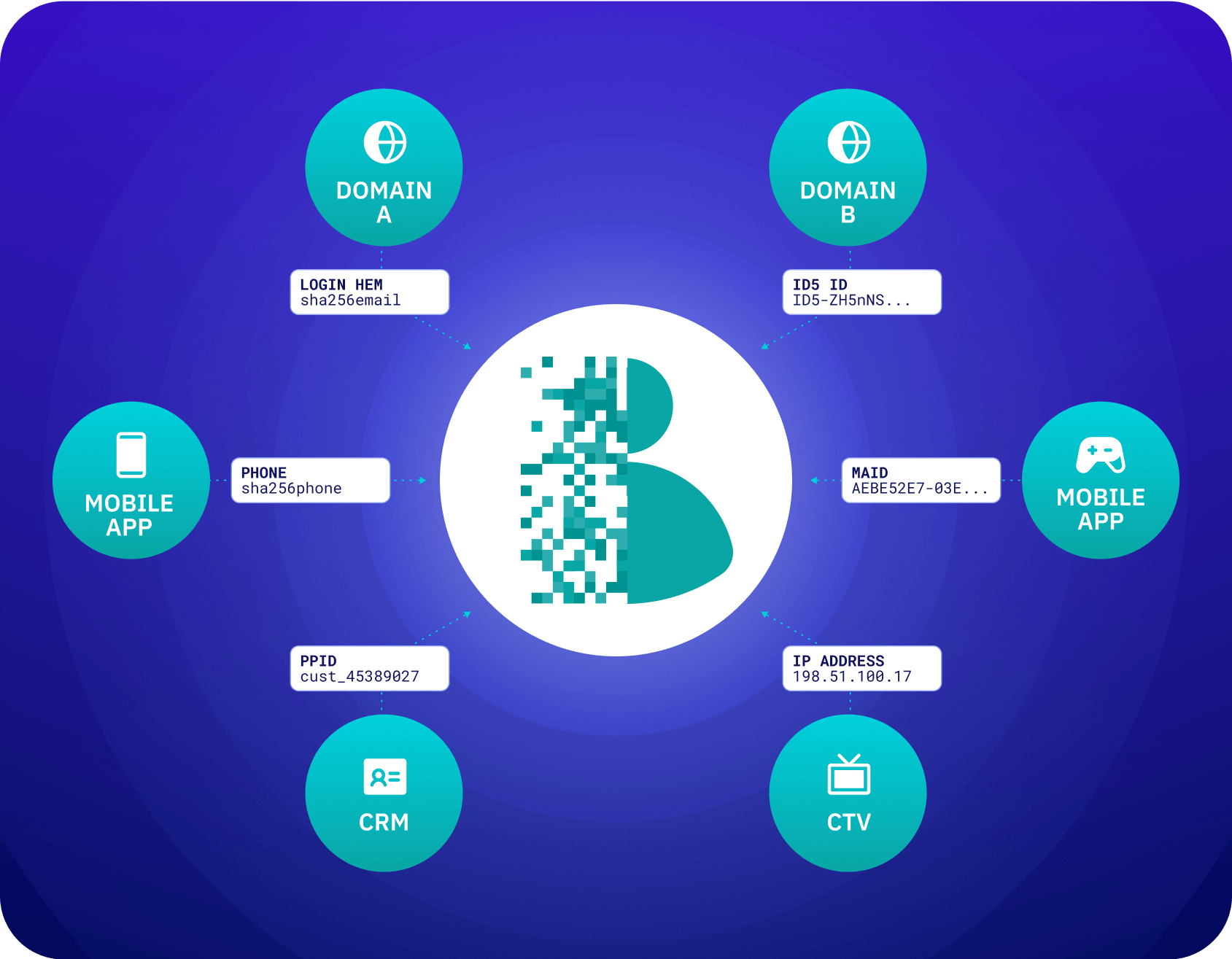
Benefits of Identity Resolution
- Builds a unified, persistent audience profile by recognizing visitors across different apps and platforms, including during anonymous browsing. This comprehensive view of the audience enables smarter monetization strategies
- Improves decision-making about advertising effectiveness by equipping publishers with more precise audience segmentation, campaign targeting, and performance analysis. Helps publishers maximize monetization across subscriptions, affiliate revenues, and advertising by optimizing user journeys based on individual preferences
- Maximizes ad revenue by identifying and forecasting targetable, high-value audiences for advertisers through rich audience segments based on demographics, behavior, and intent
- Helps publishers build customized ad campaigns by combining identity graphs with data clean room technologies
- Increases programmatic deals that offer more precise targeting capabilities and direct-sold advertising with guaranteed reach to known, high-value users
- Strengthens consumer trust by enforcing privacy, governance, and compliance standards, honoring user preferences and managing opt-outs effectively
- Positions publishers to adapt quickly and compete effectively in a changing digital landscape
- Future-proofs business strategies by shifting away from third-party data toward enriched first-party profiles. It enables subscription and membership growth through recognition of high-intent users, optimized conversion paths, and development of contextual and hybrid targeting models
Maximize Targeting Accuracy: Choosing Identity Resolution Software and Tools
Identity resolution is emerging as a key tool that helps publishers move beyond reliance on fragmented or outdated identifiers. Solution providers need to offer flexible methods of matching that respect user privacy while maintaining targeting accuracy.
When selecting an ID resolution partner, publishers should look for solutions that offer:
- Seamless data integration: The identity resolution solution efficiently and securely ingests audience data from both online and offline sources into a centralized platform, ensuring all data is aligned and accessible in one place.
- Advanced identity graphs: ID resolution platforms should integrate proprietary frameworks that enhance each profile by linking various identifiers, behavioral events, and relevant third-party data. These identity graphs should be dynamic and adaptive, evolving to incorporate behavioral signals, contextual data, and consent frameworks for a more complete user picture.
- ID Framework interoperability: The platforms shouldn’t rely on just one ID system. They should work across multiple frameworks (eg, UID2, ID5, RampID) to ensure broader compatibility and scalable partner collaboration across the advertising supply chain.
- Ongoing identity matching and maintenance: Modern tools within customer data platforms need to have the ability to continuously unify data by removing duplicates, performing intelligent matches, anonymizing sensitive details, and suppressing outdated or incorrect entries. This ensures each profile remains accurate and reflects real-time changes as new data flows in.
- Source & destination integrations: The solution needs to provide interoperability that enables smooth connectivity with external tools and platforms across the marketing and AdTech ecosystem to amplify the value and utility of resolved identity data.
- Built-in compliance controls: The vendor’s platform must safeguard publishers, advertisers, and users with integrated privacy and security measures that align with global data protection standards and regional requirements.
- Future-proofing capabilities: Vendor and ecosystem partners need to have capabilities to adopt and integrate artificial intelligence and machine learning (AI/ML) to increase the speed and accuracy of profile matching. In addition, a focus on evolving data governance frameworks and cross-functional collaboration models ensures that identity data remains accurate, secure, and responsibly used as technology and regulations evolve.
By prioritizing these capabilities, publishers can harness identity resolution to stay ahead in a privacy-first, data-driven landscape.
Powering Effective, Comprehensive Identity Resolution with Optable
Identity resolution is the essential bridge between a publisher’s data and how individuals interact across devices and channels. Optable delivers robust ID resolution by seamlessly connecting visitor data from every touchpoint, empowering publishers to engage audiences in real time and drive growth. With built-in integrations, support for interoperable identity frameworks, a compliance focus, and secure clean room applications, Optable helps publishers activate audiences confidently and adapt to evolving industry standards.
By choosing Optable, publishers invest in a scalable, future-proof solution built for today’s and tomorrow’s digital challenges and opportunities. Get in touch with us to learn more about how Optable can support identity resolution.
Below, we offer a brief overview on where to start with auditing your data and authentication strategies to adopt. To access the full guide with more details, recommendations, best practices, and case studies, download the Sell Side Guide to Identity here.
Why Authenticated Audiences Are the Future
As the digital landscape evolves beyond third-party cookies and universal identifiers, authenticated users are becoming publishers’ most critical asset. Logged-in and known audiences enable better targeting, more accurate measurement, and stronger advertiser demand. With authenticated users, publishers have access to rich first-party data that can be consistently tied to a single individual across sessions and devices, enabling deeper user profiles and long-term engagement. This level of transparency and consented data usage also allows publishers to deliver relevant content and advertising experiences, which drives higher user satisfaction and improved campaign performance.
To succeed in this shift, publishers must take ownership of their identity strategy. This means proactively defining how user data is collected, governed, and activated across the organization rather than relying on legacy systems or third-party partners to fill in the gaps. But before jumping into new tools or platforms, it's essential to fully understand the current state of your data. Without a clear picture of where your data lives and how it's managed, even the best identity strategy will fall short. Learn the first steps to take when building an identity graph.
Laying the Groundwork: Audit, Organize, and Close the Gaps
A successful identity framework starts with foundational work. You need a clear understanding of what data you have, where it's stored, and how it can be activated.
1. Locate and Organize Data
Start by mapping your data ecosystem. Identify the following:
- Which platforms collect and store your audience data
- What tools manage it (CRM, CMS, analytics, etc.)
- Where silos exist across departments or vendor systems
Once documented, consolidate your data into a centralized repository—whether it’s your own data warehouse or through a specialized platform provider. This unified foundation will power your identity graph and activation strategy. By bringing all relevant data sources into one place, publishers can reduce silos, improve data accuracy, and enable faster access for downstream tools such as customer data platforms, ad servers, and analytics systems.
2. Evaluate Identifiers and Their Usability
Not all identifiers are equally valuable or interoperable. Focus on those that are deterministically acquired and portable across environments. Deterministic identifiers such as email addresses and login IDs provide a higher level of accuracy and reliability compared with probabilistic or inferred IDs. Ensuring portability across devices, platforms, and partners allows for seamless audience targeting and measurement. By auditing both collected first-party and licensed data, you can identify which identifiers are most usable and where you have gaps.
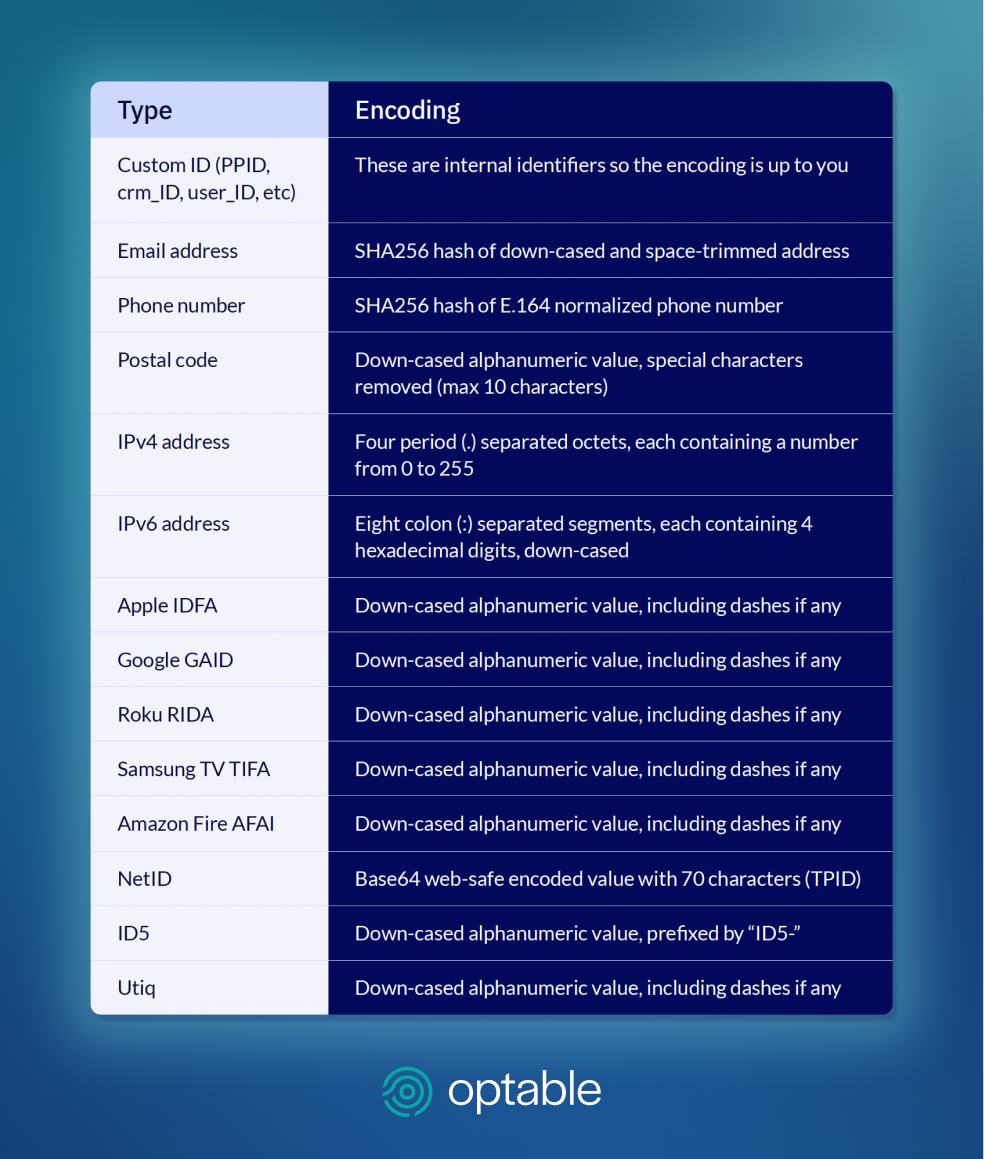
3. Understand Identity Gaps
Assess how much of your audience is already identifiable. It is important to determine the share of authenticated users with usable first-party identifiers and the portion of anonymous or unmatchable users. Those who engage with your content but cannot yet be tied to a verified identity can reveal gaps in your data collection and opportunities to convert them into known users.
This gap analysis is critical in shaping both your short-term activation strategy and your longer-term authentication approach, as it highlights where your current data falls short, which user segments are underrepresented, and which identifiers need strengthening. By understanding these gaps, you can prioritize immediate actions to better engage identifiable users while simultaneously planning initiatives that will increase authenticated user coverage over time.
Growing Authenticated Engagement
With identity gaps identified, publishers can focus on expanding their base of known users through smart, user-friendly engagement strategies. Below are a few examples.
Authentication Tactics That Work
- Platform Logins
Offer login options via trusted platforms like Google, Apple, or Facebook for easy access and high-quality data capture. - Premium Subscriptions
Use content gating or service upgrades to encourage subscriptions and collect reliable identifiers. - Email Subscriptions
Capture email addresses through newsletters or updates. These opt-ins provide a consistent and high-value ID for identity graphs. - Contests & Gated Experiences
Run interactive campaigns like sweepstakes, polls, or fantasy leagues that require login or registration. These help expand your known audience with minimal friction.
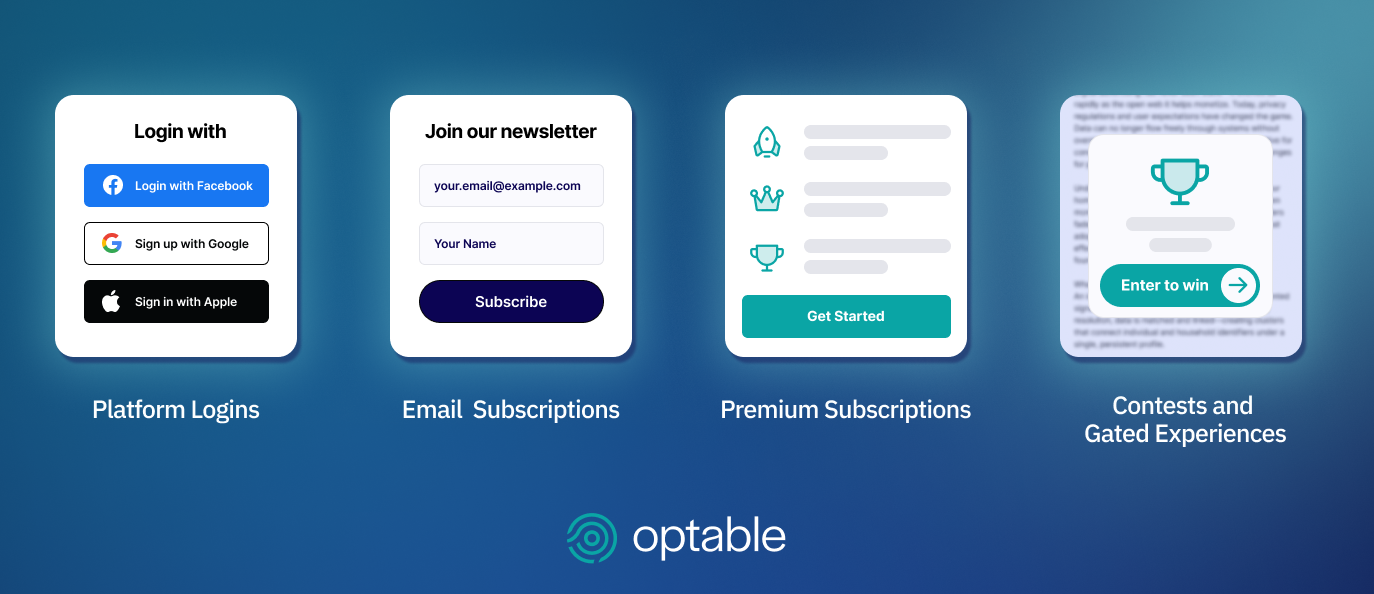
Learn More: The Sell Side Guide to Identity
The steps outlined here are just the starting point. For a more in-depth understanding on how to enhance identity strategies, explore Optable’s Sell Side Guide to Identity, which includes:
- Practical frameworks for auditing and organizing data
- A breakdown of identity technologies and clean room infrastructure
- Audience monetization strategies for both programmatic and direct sales
- Examples of how publishers are executing high-ROI identity strategies
- Checklists to get your identity project off the ground
📥 Download the guide and start building your own future-proof identity strategy today.
The digital advertising ecosystem is in the midst of a transformative shift. The IAB Tech Lab’s recently announced Containerization Project introduces a much-needed rethink of how the infrastructure powering OpenRTB functions at scale. In an environment where bid requests can measure in the millions per second, or queries per second (QPS), this volume has created significant operational costs and complexity, making it harder than ever for new buy-side players to enter the space. The result? Slower innovation in areas like ad planning, targeting, and measurement.
Containerized bidding introduces a compelling solution: rather than having every buy-side system ingest and evaluate massive streams of bid requests, the intelligence can move closer to the supply. Containers offer an execution layer where bidding logic can run more efficiently and securely within publisher- or SSP-controlled environments. This rearchitecture creates opportunities not only to reduce waste but also to unleash new kinds of business models.
Here are four major impacts this shift could have on the future of advertising:
1. Rise in Outcome-Based Bidding Models
Containerization, paired with advancements in identity resolution, enables a new class of outcome-focused bidders to thrive. These are performance-driven platforms offering Facebook-style campaign outcomes—sales, app installs, web traffic—across the open web, CTV, and mobile.
Companies like Chalice AI, tvScientific and EDO exemplify this new approach. Instead of simply evaluating CPM or CTR, their optimization engines focus on real-world actions, using AI algorithms to learn from signal patterns—time of day, ad recency, geo-performance—and adjust in near real-time. Containers provide the runtime needed to deploy these models closer to the impression opportunity, with lower latency and higher efficiency.
This could reduce the market’s reliance on generalist, self-service DSPs and encourage the rise of specialized platforms optimized around verticals, audiences, or outcomes. Importantly, it could also unlock programmatic buying for previously underserved advertiser categories—like SMBs—by making performance more accessible and measurable.
2. Audience Extension Becomes Table Stakes for Challenger Gardens & Retail Media
Audience extension—the ability to target known users or high-value segments across properties outside a publisher’s own—is becoming a cornerstone offering for large media companies, retailers, and gaming platforms alike. With containerized execution environments, these players can develop proprietary tech for targeting, activation, and optimization without needing to export sensitive audience data via data marketplaces.
The growth of “challenger gardens” is particularly notable. Media owners like Dotdash Meredith are scaling solutions such as D/Cipher, while platforms like Unity are doubling down with offerings like Audience Hub, which enables privacy-first targeting across mobile and CTV.
Containerization makes it possible for these audience extension solutions to run securely and scalably across a fragmented media landscape, accelerating their adoption and effectiveness.
3. New Models for Buying & Selling Third-Party Data
Programmatic’s recent obsession with curation—the packaging of data and inventory to meet specific advertiser needs—has become a defining theme in media transactions. There are many flavors of curation, but one of the most promising is audience curation: building targeted, scalable audience segments that can be activated across large swaths of supply.
Historically, this process relied on third-party cookies and probabilistic matching within DSPs. But as signal loss accelerates and browser-based identifiers fade, containerization offers a new route. For those companies with strong first-party data around demographics, behavior, etc., containers provide the opportunity to activate that data directly and securely at the edge—enabling deterministic matching and precise measurement.
Experian’s acquisition of Audigent reflects this shift. By combining valuable data with media execution capabilities, companies like Experian are building new monetization models that will become increasingly viable as containerization matures.
4. Cost Efficiencies Across the Ecosystem
For years, programmatic has carried an operational tax—measured in infrastructure costs, latency, and opaque margins—due to the sheer scale of QPS it processes. Containerized bidding flips this model on its head by allowing supply to host only the bidding logic necessary for a given transaction, dramatically reducing waste.
This shift creates more sustainable economics—and potentially new business models—for everyone. Buyers can reduce fees previously justified by infrastructure scale, and tech vendors can specialize without needing to run global, always-on infrastructure. In the long term, this could foster a more competitive, efficient, and innovative marketplace.
A New Architecture for a Smarter Ecosystem
The ad tech industry is often accused of being resistant to change. But containerized bidding is not just a technical refinement—it’s an architectural leap. By moving the intelligence closer to the supply, the industry can finally build systems that are more privacy-conscious, performance-oriented, and cost-efficient.
At Optable, we see this as part of a broader evolution: one where identity, data collaboration, and activation all converge in ways that benefit media owners and advertisers alike. The containerization movement is still early—and is a key part of this evolution—but its potential to level the playing field and catalyze innovation is immense. We’re excited to be part of the change.


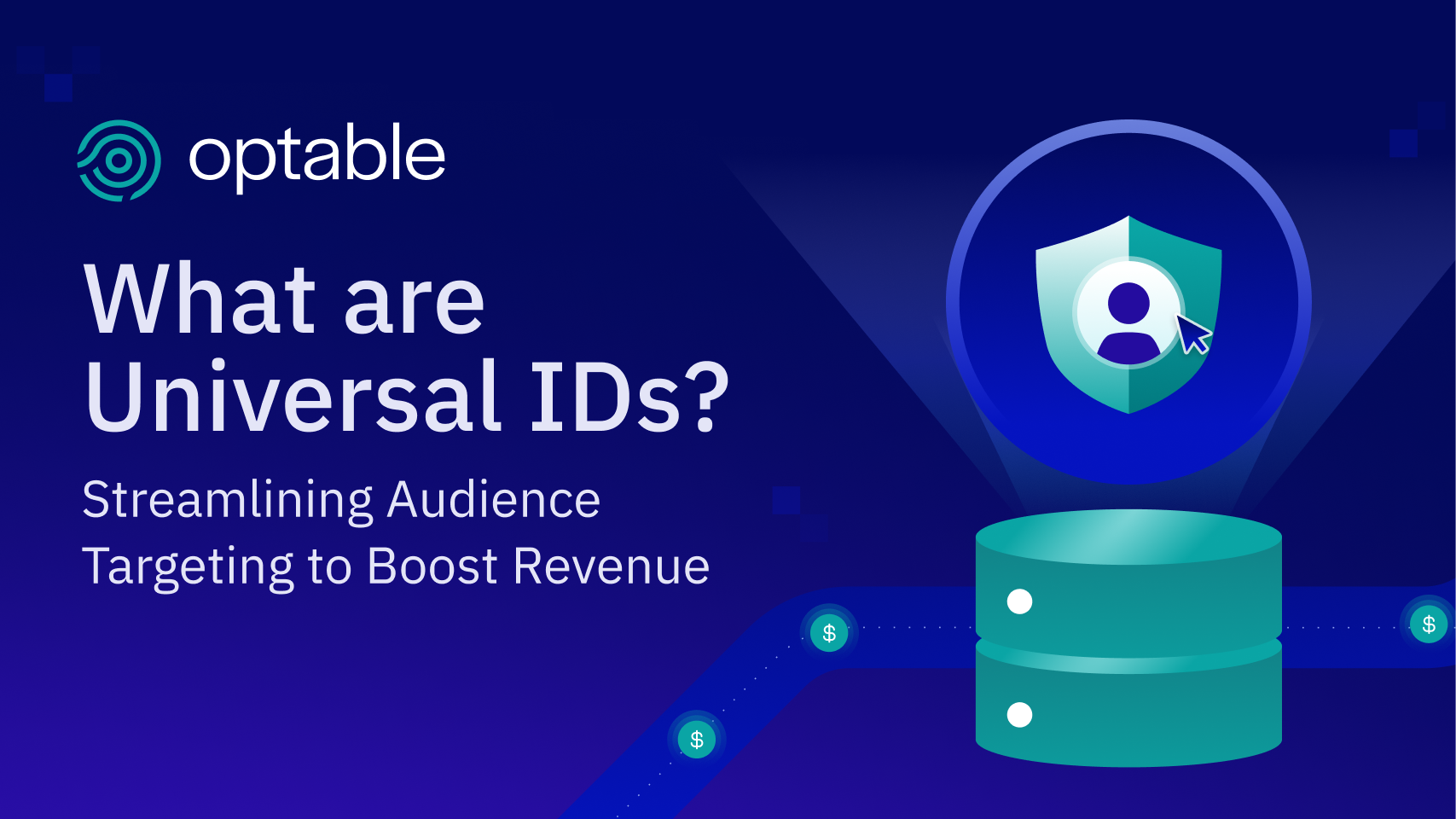
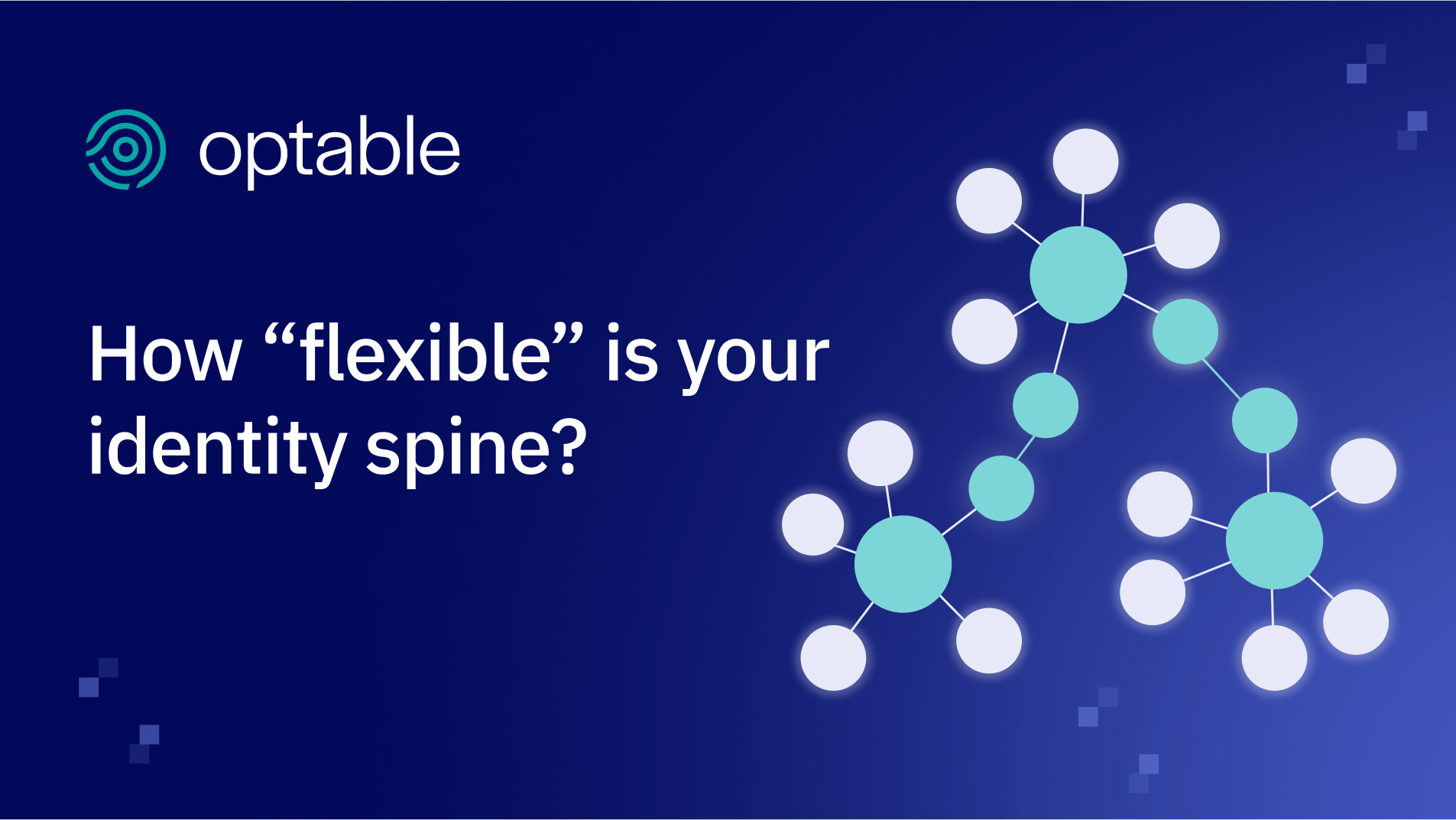
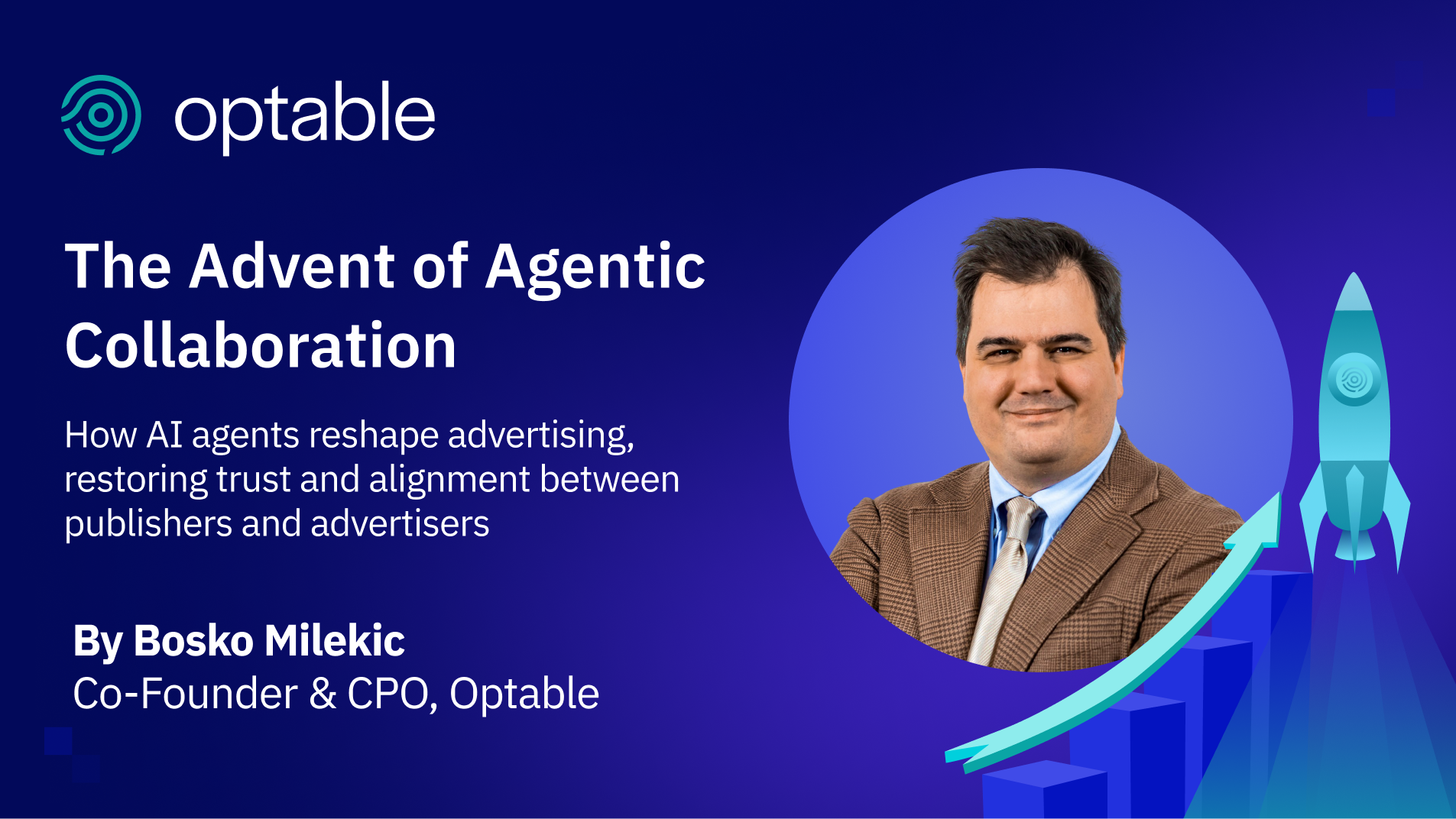
.png)
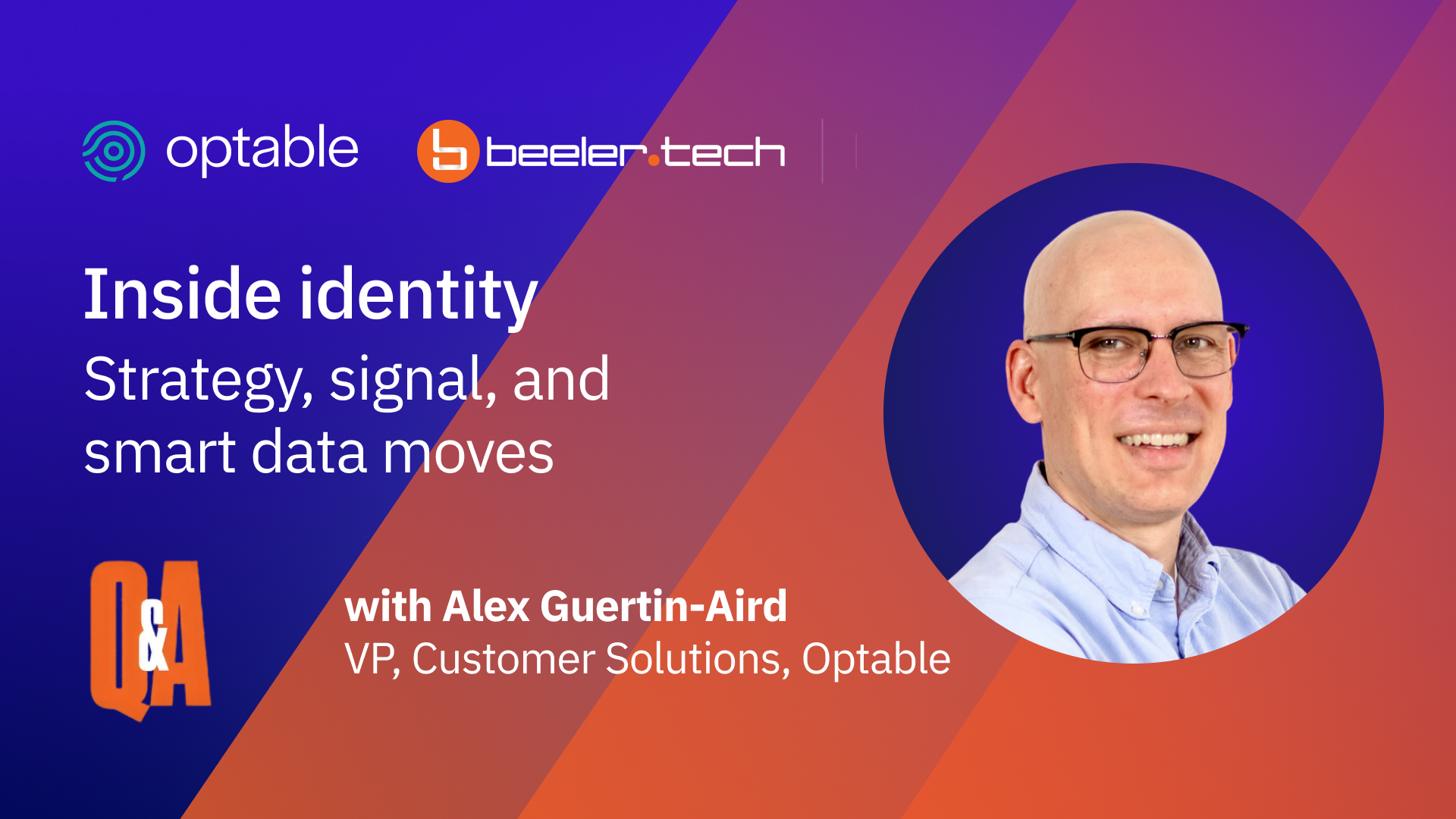
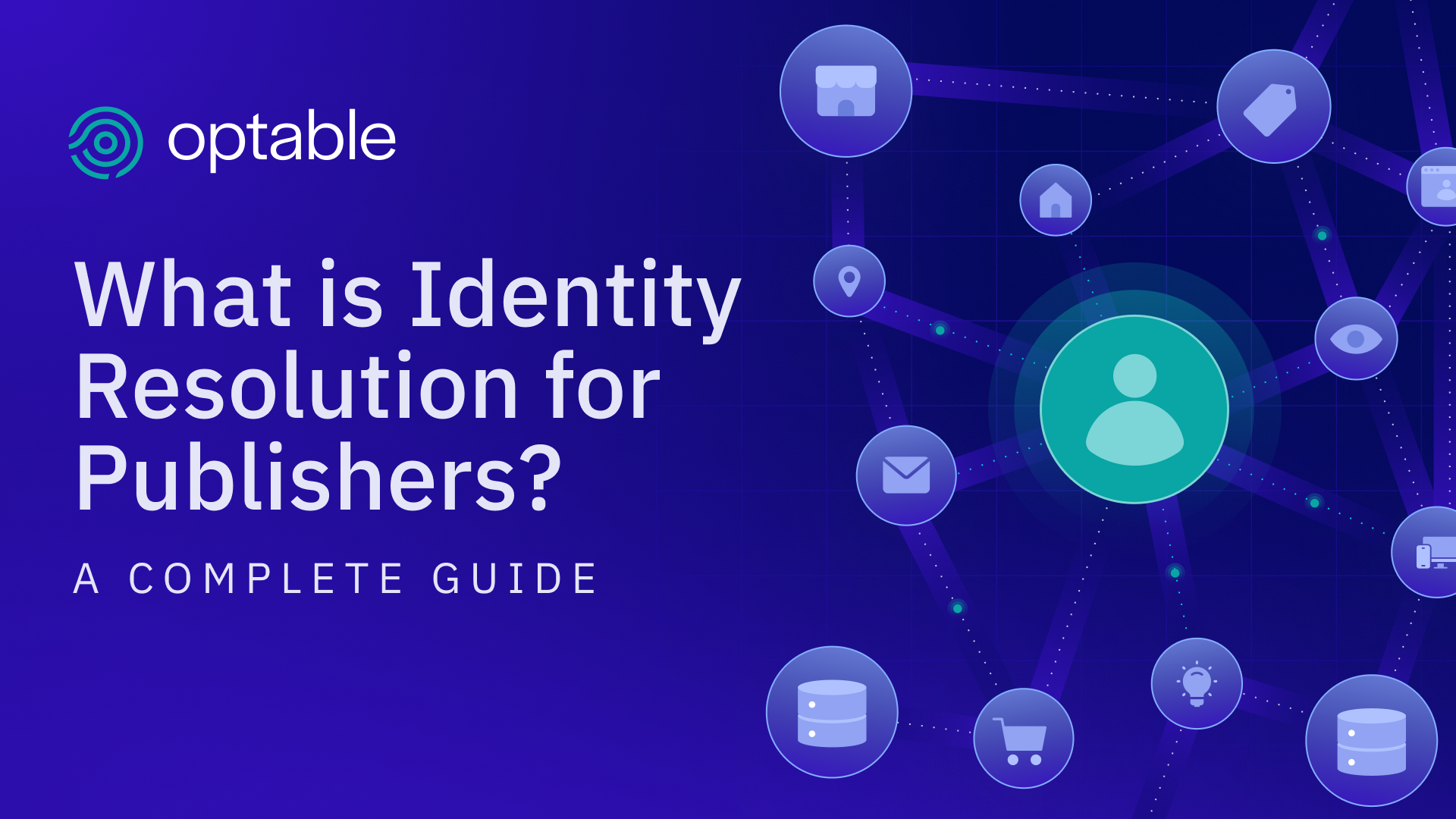
.jpg)
